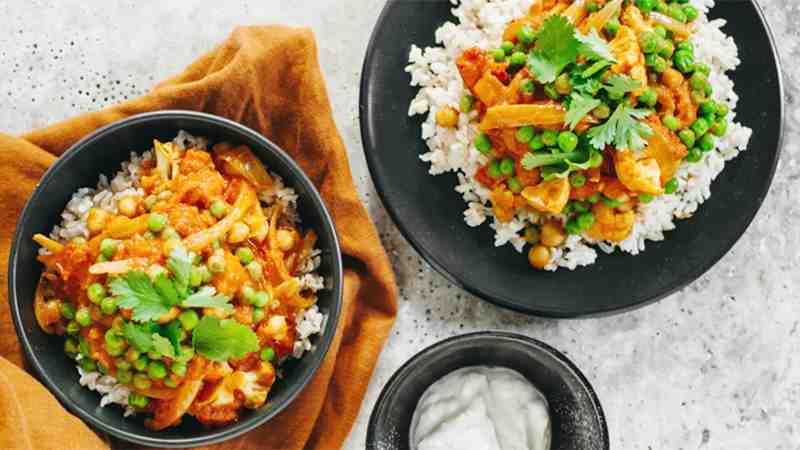Himalayan Vegetable Curry Recipe Is one of the most popular vegetarian curries in the world. It has been consumed for centuries in northwestern India, Nepal, and Pakistan.
It’s also one of the simplest curries to make, using curry powder (a spice mix), onions, ginger, and garlic paste or grated fresh ginger and garlic cloves, tomatoes puree or canned diced tomatoes with juice, vegetable oil (another staple in any Indian kitchen) and water.
This recipe was originally a whole meal, cooked in a clay pot called a “kadhai” set on top of an open flame, but it can easily be made one-skillet meal. The curry is usually served with the addition of rice or boiled quinoa, or white beans.
The general idea is to add about 6-8 tablespoons of oil over medium heat and cook the onion for about 3 minutes until translucent. Add ginger and garlic until the onion caramelizes (when it changes from translucent to reddish).

What IS Himalayan Vegetable Curry Recipe?
We’re not quite sure what the Himalayan vegetable curry recipe is. We have read a few articles that claim this cuisine originated in the mountains of Nepal and northern India, which can be confusing because the words “Himalayan” and “Indian” are often used interchangeably.
It appears to be an Indian-style dish made from local ingredients. In other words, not many spices are used either for seasoning or added as a garnish.
How To Make Himalayan Vegetable Curry Recipe?
We’ve seen lists of ingredients that include spinach, pumpkin, beans, potatoes, etc. We’ve seen lists of ingredients that include tomatoes and bell peppers.
Prepare Time: 30 minutes
Cooking Time: 20 minutes
Servings: 2-3
Ingredients
- 1 medium onion
- 1 tablespoon ginger or garlic paste
- 2 medium tomatoes, or 2 tablespoons tomato puree/sauce
- 3 cloves fresh garlic, or 1 teaspoon garlic powder
- 2 tablespoons curry powder
- 3/4 cup water (if using fresh vegetables) OR 1 cup water (if using canned vegetables)
Note
If you are using coconut milk, do not add water. In this case, use half a can of tomato puree instead. Serves 2-3.
Method
Step 1. Heat oil in a pan, add chopped onions, and fry until golden brown.
Step 2. Add ginger and garlic paste, mix well and fry for 3-5 minutes until the raw smell disappears.
Step 3. Add tomatoes, curry powder, and water (if fresh vegetables are used), stir well, and simmer on medium heat.
Step 4. Chop the vegetables into small pieces and lightly cook in vegetable stock or water for 5 minutes or until tender if using fresh vegetables or 10-15 minutes if using canned vegetables.
Step 5. Add chopped vegetables and mix well. Cover and simmer on low heat for 5-7 minutes.
Recipe Notes
• You may add chopped green chili peppers if you like spicy dishes.
• The recipe can be halved or doubled depending on the number of people you serve. It also freezes very well to be stored in the freezer for future use.
• You can add more salt after cooking to suit your taste since the amount needed will depend on how salty your vegetable stock is.
• You can serve this dish with bread or over rice.
• The vegetables used in this recipe can be substituted with other varieties of your choice.
• Instead of coconut milk, you can add cream or half and half in the water when simmering.
5 Healthy benefits Of Himalayan Vegetable Curry Recipe
1. Garlic
Garlic is a powerful antimicrobial agent (antibiotic) and antifungal. It is also one of the most powerful weapons against cancer cells.
2. Ginger
Ginger contains compounds that are thought to have anti-inflammatory effects, and it may also help relieve nausea and vomiting associated with morning sickness.
3. Onions
Onions contain flavonoids responsible for their unique sulfur-containing aroma, which can help prevent certain cancers such as colon cancer.
4. Tomatoes
Tomatoes are loaded with cancer-fighting carotenoids such as lycopene. Lycopene specifically has been associated with a lower risk of prostate cancer and may also help prevent lung and bladder cancers.
5. Curry
Curry contains turmeric, one of the most powerful anti-inflammatory agents. It also is an excellent herb for treating depression, inflammation, asthma, and arthritis.
Conclusion
This recipe is highly nutritious and delicious. It is one of our favorite recipes. We hope you like this recipe. Please do not forget to share it with your friends and family. Thank you for visiting our website.